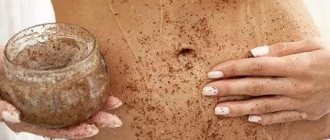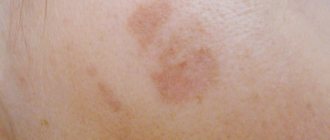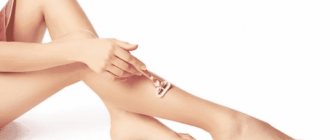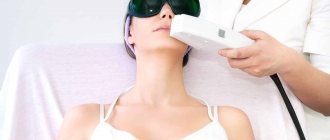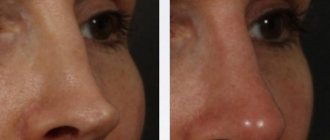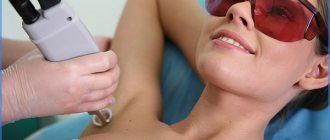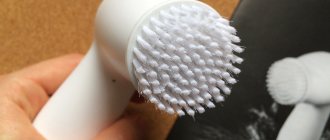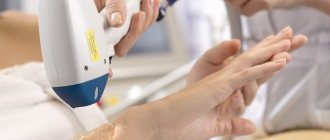BRIEFLY ABOUT THE PROCEDURE
To remove unaesthetic hair, depilation is often used.
It consists of removing hair from the surface of the skin. In this case, the hair follicles are not affected. And after a short time the problem returns. If you resort to hair removal, you can forget about the problem for about a month. This method acts deeper and allows you to get rid of hair along with the follicles. If the second path is chosen (removal with wax, melted sugar or epilator), the damage affects the inner layers. Microtraumas form in areas where hair grows. If a product from the sebaceous glands gets into the wound or, in a particularly unpleasant case, an infection, the problem becomes more acute.
Main reasons
There are many reasons for irritation after waxing. The most common ones include:
- low quality wax;
- incorrect implementation of the procedure, violation of the instructions for using the product;
- sensitive skin;
- allergy to wax or auxiliary elements of hair removal products;
- the presence of damage to the treated area of the skin (scratches, wounds);
- recent depilation of the treated area with a razor or epilator;
- contact after the procedure of the treated skin area with synthetic materials;
- applying foundation or creams or other products that contain alcohol to the treated skin.
Thus, the appearance of irritation can be caused not only by the procedure itself or the hair removal product, but also by a violation of safety rules after the session. It is necessary to strictly follow the instructions for handling wax when epilating; the slightest deviation can lead to unpleasant consequences.
Why does irritation occur?
- After shaving. For women - on the legs, armpits, in the bikini area, and for men - on the face.
- After hair removal with depilatory creams.
- After using wax or sugar paste.
If after such procedures you have acne, it means that you urgently need to find the cause and a way to combat it. It is especially unpleasant when such “joy” settles on the face, because the legs and other parts of the body can still be hidden from prying eyes, but the face cannot.
Sometimes the cause of acne can be ingrown hairs - a common consequence of depilation. As a result of shaving or pulling out a hair against its growth, it (the hair) becomes curved and begins to grow in a different direction, i.e. under the skin. A purulent inflammation occurs at this site, and the deeper the hair grows, the more difficult it is to cure this inflammation.
Another reason is an infection in the pores or hair follicles. This can happen if you depilate with dirty hands, an old razor, or poor-quality wax. The infection gets under the skin, local infection begins, and, as a result, nasty purulent pimples.
Why do acne appear after waxing?
Ulcers, irritations, and swellings form for various reasons. It is necessary to familiarize yourself with all possible factors in order to eliminate them in the future.
So, the causes of acne after depilation:
- Very sensitive skin. The epidermis has increased sensitivity to external irritants. Any aggressive effect on the skin leads to a state of irritation. Girls who have just started hair removal often face this problem. Over time, the dermis may get used to it and acne will not appear, but it happens that the skin continues to react to the procedure with inflammation for a long time.
- Neglect of hygiene and sterility standards. During depilation, especially where hair is removed along with the root, the upper skin layer is broken, the holes where the hairs were remain open. Microbes instantly penetrate the damaged layers of the epidermis and begin to multiply. It is very important that during the process everything is sterile and disinfected.
- Allergic reaction. The body may react to the hair removal material or the procedure itself with an allergy. Pustules appear after sugaring, waxing, chemical epilator cream, as a reaction to the material. This allergy may be accompanied by itching and swelling of the epilated areas.
- Infection. During the procedure, there is a risk of infection, causing purulent formations on the skin. Harmful microorganisms can be found anywhere: on the hands of the master, auxiliary tools, in the wax itself (if dirty hands were immersed in it).
- Hormonal disorders. Due to hormonal imbalance, pustules often appear in the bikini area, groin, and on the face in the lower part. Aggressive effects on the skin further stimulate their reproduction.
- Clogged hair pores. Some cosmetics used after depilation (creams, lotions) clog the hair holes, preventing them from healing naturally. Inflammatory processes begin inside the pores, resulting in ulcers.
MANIFESTATION OF CONSEQUENCES
Regardless of skin type, amount of unwanted hair, or method of removing it, signs of irritation look like this:
- increased skin dryness;
- possible peeling;
- red dots;
- large areas of redness;
- ingrown hairs and the appearance of pustules.
Don't worry right away. After 3 hours, the redness should go away. In the case of particularly sensitive skin, the process may take a couple of days. If during this time the symptoms do not disappear, but, on the contrary, worsen, immediately go to see a specialist. There is no need to waste precious time on treatment at home.
If, despite all efforts and prevention, skin irritation occurs and causes great inconvenience, then simple tips will help save the situation. Those who perform depilation and hair removal at home need to know them especially. A quick response can solve the problem in a short time and alleviate the skin condition. There are various substances that can relieve painful manifestations. These can be medications, caring creams, folk recipes.
We suggest you read: Pills for hair growth after chemotherapy
SPECIAL PRODUCTS They can be purchased at a pharmacy or cosmetics store and used at home. They will quickly relieve your skin condition.
- Antiseptic ointments.
- Baby powder.
- Solutions with levomycin or chlorhexidine. It is recommended to treat the affected areas with epilation 3 times a day until the symptoms disappear. Usually 5 days is enough.
- Medicines to combat burns. A spray with panthenol gives a good effect. After exposure, excess is removed with a special napkin.
- Hydrogen peroxide solution. Treat the skin with a damp cotton swab, and then apply a moisturizer.
- Baby cream can relieve irritation and stop the inflammatory process. It is rubbed into the problem area with light movements.
- After shaving gel or a special cream after depilation can remove all unpleasant manifestations.
RECIPES FROM THE PEOPLE'S PIGGY BANK It happens that hair removal has been carried out, but there are no suitable preparations for subsequent care at hand. You can look for the necessary substances at home and prepare medicinal formulations from what you have on hand:
- Potato. Peel a small root vegetable and chop it on a fine grater. The prepared paste is applied to the irritated area for 10 minutes. Afterwards, wash off with cool water and lubricate with baby cream.
- Aloe. The plant leaf needs to be washed, the side spines cut off, and divided into two parts. They are applied to the skin. Action time: 30 minutes. Then rinse with water and apply a care composition.
- Turmeric. From 2 tbsp. l. product and warm water prepare a paste. It is applied to the area affected by hair removal. After 20 minutes, the residues are removed with water and a kefir mask is made.
- Tea tree oil. For 1 tbsp. l. 2-3 drops of the drug are added to olive oil. This mixture has an anti-inflammatory, antibacterial and healing effect. Use it as a care composition, allow it to absorb, and remove the residue with a clean napkin. Eucalyptus oil also works.
- Medicinal herbs. Lotions made from decoctions of chamomile, calendula, celandine, and string can quickly remove irritation from depilation. They are done several times a day. You can freeze ice cubes from herbal infusions and wipe the skin. This also brings relief.
Getting rid of excess hair at home is not difficult if you know all the rules of the procedure. It is more difficult to cope with the possible consequences. But here, too, there are many ways to relieve the effects of depilation. Use only quality products. For post-hair removal care, choose creams and lotions from the children's series. They undergo strict control and minimize the risk of negative effects on the skin. This is especially important if a problem occurs.
The information published on this site is for reference only. Before using it in practice, be sure to consult your doctor.
Irritation after bikini hair removal
Five simple recommendations - and no irritation after hair removal
Irritation after bikini hair removal
Women are constantly improving their bodies, trying not to miss a centimeter. Hair removal has long become commonplace - almost everyone has performed this procedure at least once.
Unwanted hair is removed from any part of the body, it is not necessary that it is always visible. Traditional areas where many people epilate include the bikini area.
Features of the bikini area
Epilation of the bikini area is extremely delicate both aesthetically and cosmetologically. Due to evolutionary features, hair growth in this area is quite active, but not everyone is happy with this. Of course, the presence of hair is necessary for the protective functions of the body, but many people prefer to get rid of excess hair.
For clarity, the bikini area is an area covered by fairly revealing underwear or a swimsuit. Everything that “extends” beyond the edges of the clothing is removed.
The main feature of this area of the body is sensitive and delicate skin. Any incorrect influence leads to problems.
Possible problems with hair removal
If, when epilating in the bikini area, you choose the wrong method of hair removal, or carry out the procedure without the proper experience, then undesirable consequences may occur:
- irritation;
- burns;
- itching;
- redness;
- the appearance of dots at the site of hair growth.
How to avoid irritation
With the right approach to choosing the procedure, technician and materials, irritation after bikini hair removal can be minimized.
- Decide on the method of epilation. There are many options - from traditional (wax, razor or epilator) to modern hardware methods (laser or photo hair removal).
If you find it difficult to choose the best method for removing unwanted hair, contact a spa or specialized beauty studio. Master cosmetologists will help you with your choice, and will also competently and professionally carry out the hair removal itself.
- Prepare your skin for the session. Each method has its own recommendations that will help minimize discomfort and promote a positive effect.
For example, when choosing laser hair removal, exclude exposure to ultraviolet radiation on the skin for the entire course. And when using sugar paste (sugaring), use additional materials that contribute to the desired result.
Again, only an experienced cosmetologist can take into account all the nuances. Therefore, visiting a salon for hair removal is not a luxury, but a necessity. The bikini area is not the place to experiment with your body.
- Use only high-quality materials and hair removal products. The components they contain can cause irritation even on untreated areas of the skin. Therefore, try to take into account the individual characteristics of the body.
- If irritation does appear after epilation of the bikini area, there are several proven ways to remove it:
- use special preparations that contain soothing, analgesic and anti-irritation components (for example, Panthenol);
- you can make a five-minute mask - crush three aspirin tablets and mix with a tablespoon of glycerin - it perfectly relieves the symptoms of irritation;
- treat the hair removal area with tea tree oil;
- aloe is a miraculous plant that has a wonderful effect on the skin - take a leaf, cut it and treat the epilated areas with the pulp;
- Baby anti-irritation cream is also great for the bikini area - no redness or other problems.
- Also, according to reviews on the Internet, moisturizing creams and shaving gels designed for sensitive skin are very helpful in preventing irritation.
The bikini area requires a competent approach when carrying out cosmetic procedures. That is why it is better to epilate this part of the body in a salon. Moreover, the price of such procedures in Moscow is quite affordable, even without taking into account possible discounts. And experienced cosmetologists will do bikini hair removal much more efficiently and painlessly than you will try to do it yourself.
In addition, the cosmetology studio will select a procedure for you that takes into account the characteristics of your skin and hair condition. If this is not done, the effectiveness of hair removal will not be achieved.
So don’t deny yourself the pleasure of becoming even more beautiful.
Causes of irritation
Getting rid of unwanted hair without getting irritated is quite problematic. And there are several reasons for this. At home, the risk is greater.
- Representatives with sensitive fair skin are especially affected.
- When using a razor, even with the most careful handling, injury to the epidermis occurs.
- If you are a beginner and decided to do this for the first time, then tolerance may improve after 2-3 sessions.
- A possible allergic reaction to the components of the hair removal product may result in severe redness and itching. To avoid this, it is worth testing in a small area.
- Expired wax or depilatory cream can cause big problems. It is important to always check the expiration date.
- Neglecting the care procedure after hair removal increases the likelihood of unpleasant consequences.
- A low pain threshold will require a local anesthetic. When epilating mechanically, it is worth getting a cooling attachment for the device.
- Lack of experience and knowledge of proper procedure at home can lead to irritation.
We invite you to read: Alopecia areata: treatment with drugs, salon and folk methods
Every woman is fully capable of reducing the risk of undesirable consequences of depilation. When performing, follow the rules, prepare the skin for the procedure, use caring creams. For particularly problematic cases, it is worth purchasing medications for use at home.
Most women depilate at home using a razor, various waxes and creams. Unfortunately, any of these methods can cause inflammation in the skin in the area where depilation was performed. Such irritation after depilation on the face, legs, arms or intimate parts of the body can be temporary or remain for a long time. In this case, the woman will have to forget about decorative cosmetics, short skirts and open swimsuits for a while.
Although irritation after waxing or any similar procedure is quite common and normal. The cause is damage to the nerve endings located near the fatty ducts to which the hair follicles are attached. During the process of shaving or pulling out hairs, the nerve endings are irritated, and the released fat contributes to inflammation.
According to professionals, inflammation on the skin after depilation is a completely adequate reaction of the body. This is due, first of all, to the partial removal of the upper layers of the epidermis along with the hair, as well as to the stress that the skin experiences during the first depilation session. All this ultimately leads to the discovery of multiple red spots, inflammations and other “surprises” on the body.
Causes of folliculitis after laser and wax hair removal
The inflammatory process in question does not occur in every client undergoing laser or wax hair removal procedures. The causes of folliculitis in this case may be:
- an illiterate procedure – the algorithm of laser exposure was violated, the depth of laser penetration was incorrectly calculated, no disinfection measures were carried out before waxing;
- the client visiting the pool or sauna/bath between laser or wax hair removal procedures;
- mechanical damage to the skin during direct manipulation;
- Carrying out the procedure in question for a client with hyperhidrosis (excessive sweating).
We recommend reading about electrolysis of hair. You will learn about the types of electrolysis of hair, the benefits of the procedure, facial skin care afterward, and the consequences. And here is more information about laser facial hair removal.
Remedies for skin irritation
Now let's talk about how to remove irritation on the face, legs or bikini area if it is not caused by ingrown hairs. In this case, it either occurs due to infection, or is a consequence of the individual reaction of your skin to rough impact from a razor or other depilatory means.
The following will help you with purulent acne:
- Salicylic acid, which will quickly cope with irritation, kill germs, and make the skin clean.
- Post-depilation cream, spray or ointment: Vagisil, Panthenol, Bepanten, zinc ointment, hydrocortisone ointment, and the like. All of them, in one way or another, effectively cope with skin irritations in a short time. They are easy to use: you need to apply a small amount of cream or ointment after depilation and let it absorb. Some of them have contraindications, so be sure to read the instructions before use.
- Chlorhexidine, hydrogen peroxide - these products will also kill the infection that has entered the pores, and will easily cope with mild irritation.
We suggest you read: Castor oil and hair growth
Acne Treatment Methods
Treatment of acne after depilation can be divided into two types:
- Medication
- Traditional ways
Antibiotic ointments
Miramistin, Levomekol, Erythromycin, Tetracycline, Baneocin, Fusiderm - these drugs have a wide spectrum of action, fight harmful microorganisms, relieve inflammation, heal wounds and ulcers. They can be used to treat acne on the pubic area, legs, arms, face. Each ointment contains instructions, which indicate the rules of use and contraindications.
Healing anti-inflammatory ointments/creams
Radevit, Zenerit, Bepanten, D-panthenol, Boro Plus - these ointments and creams contain regenerating and healing components, quickly relieve redness, rashes, small pustules, swelling, itching.
Antibacterial solutions
Miramistin, Chlorhexidine, Hexicon, Furacilin, Chlorophyllipt, Hydrogen Peroxide - preparations in liquid form are intended for treating inflamed areas of the skin. All of them have a powerful antiseptic, bactericidal effect, and quickly relieve inflammatory processes.
Folk remedies for pimples after depilation
- If acne appears after shaving the intimate area, you can treat the skin with a weak solution of manganese immediately after the procedure and for a few days after. Potassium permanganate not only has antiseptic and anti-inflammatory properties, but also prevents hair growth. It is not recommended to use it in other areas, as the skin may darken slightly for a while.
- Aloe juice is an excellent remedy for any inflammation. You can make a compress out of it or simply lubricate irritated areas. Kalanchoe and plantain have the same healing properties.
- To prevent acne from occurring after sugaring, waxing, or an epilator (methods in which hair is removed from the roots), it is recommended to treat the skin with chamomile or calendula infusion.
- After shaving in the bikini area, legs or armpits, you can wipe the skin with a decoction of the string. The herb has antiallergic and antiseptic properties.
- Essential oils of eucalyptus, fir, lemongrass, saffron, and mint prevent inflammation. But they should be used diluted: for 10 drops of base oil (any cosmetic) 2 drops of essential oil.
- Pimples will not appear on your legs or there will be fewer of them if you powder your skin with baby powder immediately after depilation.
PREVENTIVE ACTION
If you take simple steps, you can minimize irritation after waxing at home. These tips relate to skin preparation, the process and what to do afterwards:
- If you are epilating with wax, molten sugar, or an electric device, a bath will help. It will steam the skin, expand the pores and make hair removal easier. It is important to thoroughly blot the surface of the body from water before starting.
- Women with delicate skin can try to get rid of hair using movements in the direction of growth. It will take longer, and the irritation will be less than usual.
- You should not treat the same area of the body several times. This applies to a razor, wax, epilator, special cream, etc. It is better to remove the remaining hairs during depilation another time or remove with tweezers.
- You cannot use a scrub and a washcloth on the first day after the hair removal procedure. And also try to refrain from scratching, so as not to cause even more damage.
- During the first 3 hours you should not take water procedures, and it is better to rinse off the depilatory cream with cool water. This will prevent pores from enlarging and unwanted substances from entering. And you should refrain from visiting the sauna, pool or swimming in open water for two days.
- To protect from sun rays, use moisturizers that do not contain α- and β-hydroxy acids. They can cause irritation and inflammation. In general, it’s better to avoid sunbathing at first. The use of self-tanning is also undesirable.
- A greasy product or caring lotion without alcohol additives will help soothe the skin after hair removal.
Features of acne that occurs after depilation
Acne after hair removal varies in the nature of the rash. There are white pimples, red pimples with purulent contents, black dots, painful large bumps, and blisters.
They appear in any part of the body where depilation was performed.
Some women remove hairs above the lip and in the chin area. Most often, a small pustular or red rash appears in this area. The skin on the face is tender and sensitive, reacts with irritation to external aggressive interference.
Armpits
Acne after shaving, waxing, sugaring or any other method most often occurs due to non-compliance with the rules of caring for the skin of the armpits after the procedure. Some people immediately apply antiperspirant to their armpits, which completely clogs the sockets of the hair follicles. This contributes to the appearance of blackheads, painful large pimples and redness.
Bikini
Irritation, pimples, ulcers on the pubic area after shaving are a very common occurrence. Trouble may appear in the intimate area after shaving, epilator cream, machine, wax, laser hair removal. The skin in the bikini area is also very sensitive and is constantly in contact with underwear. The cause of the reaction can be a variety of factors, from individual sensitivity to infection.
The skin on your feet is less sensitive. Purulent and red pimples after hair removal are mainly localized on the thighs, where the epidermis is thinner. The problem often occurs in the summer, when dust gets on exposed legs or a woman, without following the rules, sunbathes and swims in open water in the first days after depilation.
Tips and tricks
It is much easier to prevent irritation after depilation of the face, legs or other parts of the body than to treat them for a long time and tediously. For this it is enough:
- maintain hygiene;
- moisturize the skin daily with creams, preferably herbal ones;
- use antiseptic drugs after depilation;
- do not visit baths, swimming pools, saunas during the day;
- do not shower/bath for 2-3 hours;
- When going out into the sun immediately after the procedure, use sunscreen.
How to relieve irritation after sugaring using pharmaceutical and folk remedies
You can remove irritation after sugaring and eliminate unwanted consequences using pharmaceutical and folk remedies that have an antihistamine and sedative effect.
The main task is to relieve inflammation and soothe red skin.
The products are used for applications, creams and rubbing into the skin.
Pharmacy products
From pharmaceutical products, the use of ointments, creams and moisturizing lotions is recommended. All products are applied to the skin 1-2 times a day.
The following remedies help reduce inflammation:
- Butadione Ointment, the main active ingredient is phenylbutazone. It is an NSAID (nonsteroidal anti-inflammatory drug) that has anti-inflammatory effects. To eliminate the symptom, apply the product to the affected area and leave to absorb. Repeat the procedure 2 times a day until the inflammation disappears.
- Boro Plus Available in 2 forms - cream and moisturizing lotion. The cream has an antiseptic effect. It helps relieve inflammation, quickly removes redness and itching. They need to anoint the skin (1-2 times/24 hours).
- Levomekol Ointment has an anti-inflammatory and antimicrobial effect. Easily penetrates deep into tissues, promotes tissue regeneration. Used when pustules appear. It is applied to a sterile swab and attached to the abscess. Applications should be made until complete recovery, 2-4 times/24 hours.
- Chlorhexidine Has an antiseptic effect. Effective for dermatitis. The skin should be lubricated daily, 2-3 times/24 hours.
- Salicylic-zinc ointment Antiseptic, disinfectant. It has anti-inflammatory, antiseptic, keratolytic and drying effects. Effective in the fight against eczema and “wet” pimples. Apply 1-2 times/24 hours.
Folk methods of struggle
Recommended folk methods of struggle are potato juice, honey, chamomile decoction, aloe juice, calendula decoction.
Important! Some folk remedies (honey, chamomile) can cause an allergic reaction.
It is recommended to use the following recipes:
- Potato juice Has an antihistamine and healing effect. Method of application - applications with grated fresh potatoes, which are applied to the skin during the day.
- Honey Relieves itching, dryness and small pimples. Honey melted in a water bath is rubbed into the skin and left to be absorbed. The effect occurs within 3-4 hours.
- Chamomile decoction 2 tsp of pharmaceutical chamomile is poured into 150 ml of boiling water, infused for 35 minutes, cooled and filtered. The decoction is used for compresses that are applied at night.
- Aloe juice Fresh plant juice is used. It is rubbed into the skin 2-3 times/24 hours.
- Calendula decoction 2 tsp. the product is poured into 200 ml of boiling water, infused for 45 minutes, judged, filtered. Used for compresses, which are applied 1-2 times/1 day.
How to avoid skin irritation after waxing
- After depilation, do not rub or scratch the skin. It will cause damage
the top layer of the skin. In this case, you can get an infection. - Remains of a cosmetic product that is directly intended for depilation must be washed off with cold water. This will quickly narrow the pores and not harm the skin.
- After depilation, you should not rub your legs with a towel. It is better to take a paper napkin and gently blot it to remove any remaining moisture.
- After the procedure, it is recommended to shower with antibacterial gel or soap. Then apply an antibacterial agent to a cotton pad and apply to areas where severe irritation appears.
- Never use talc after waxing.
- After such a procedure, you must apply special creams that are designed to relieve irritation and moisturize the skin.
Please note that all cosmetics used during and after hair removal must be suitable. Otherwise, you risk increasing irritation, and a trip to the doctor will then be inevitable. Follow all the recommendations and then your legs will be smooth as silk. The topic of our next article: Are your feet tired in heels? There is an exit!
